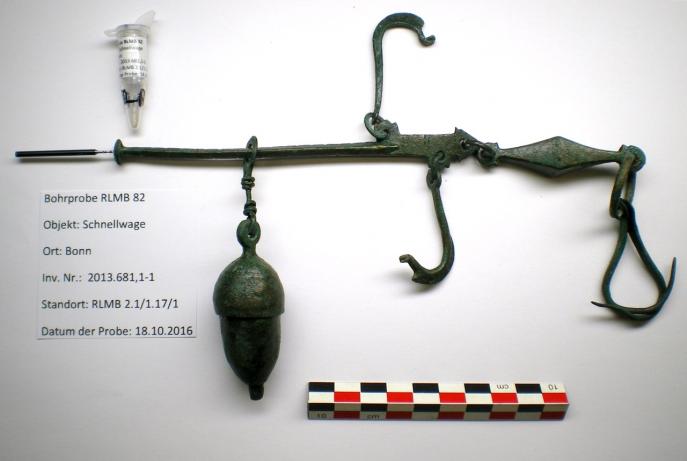Hardly any other technique has more permanently influenced the development of early civilizations than weighing. Using scales and weights, things could be compared in an entirely new way. Equivalencies measured and expressed as the weight of precious metals created the preconditions for a new method of estimating value and facilitating exchange. This set the course for historical developments that continue to have effect even today. The project looks at the long-term history of weighing with a special focus on the question of how the developments of this technology and the cultural evolution of knowledge in different domains have affected one another.

Detail of the scale pan suspension of a Roman steelyard preserved in the Museo Archeologico in Naples. For technical reasons the suspension has to be rather heavy. This was realized by using long chains. The component in the image, which presumably was borrowed from the domain of jewellery production, kept such long chains from entangling when the balance was being transported. Photo: Jochen Büttner, CC BY-SA.
Weighing emerged almost 2500 years before its first scientific reflection. External representations associated with weighing technology led to a transformation and extension of social and cognitive structures long before that, not all of which related directly to weighing. This investigation focuses in particular on ancient balances with arms of variable length, the most familiar of which is the Roman balance, also referred to as the steelyard. With the design of steelyards, technological knowledge enabled mechanical problems to be solved for which no solution was available in the realm of theoretical knowledge. Problems related to the steelyard indeed remained central to a science of mechanics for a long time to come.
An outstanding result of this project was the identification a hitherto unknown facet of ancient technology: the production of technological artifacts according to complex rules that determine these objects with their essential properties. In consequence, it is ultimately these rules and the knowledge they represent that enabled the technological objects to fulfill their assigned functions. The reconstruction of such rules thus discloses the specific technological knowledge intrinsic to the construction of particular technological objects. The differentiation and development of the rules underlying their construction, moreover, characterizes the innovation processes that these different technological objects underwent during antiquity.

Schnellwage Bonn. Taking a metal sample from Roman steelyard preserved in the LVR-LandesMuseum Bonn. The samples were analyzed to probe the alloy composition used in the production of the instruments. By means of Lead Isotope Analysis the geographical origin of lead used in manufacture was determined to allow for an inference as to where the balances might have been produced. Photo: Frank Willer, CC BY-SA
The development of weighing technology with its more than 5000-year history represents a paradigmatic case for studying the mechanisms that shaped the interplay between technological innovation and the diffusion and development of knowledge—both practical and theoretical—in the ancient global world. From its onset, weighing had an enormous impact on societies, giving rise to often radical changes in different domains, of which economics is the most prominent. Knowledge intrinsic to and produced in different domains of cultural activity thus in turn became a prerequisite for technological production. Knowledge transfer processes are thus revealed as being decisive in the shaping of technological innovation.

